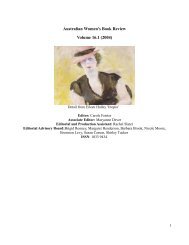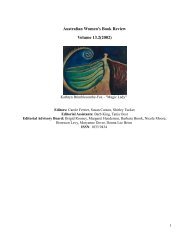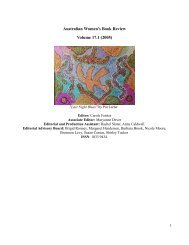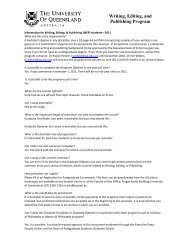Australian Women's Book Review Volume 14.1 - School of English ...
Australian Women's Book Review Volume 14.1 - School of English ...
Australian Women's Book Review Volume 14.1 - School of English ...
You also want an ePaper? Increase the reach of your titles
YUMPU automatically turns print PDFs into web optimized ePapers that Google loves.
healthy theatre industry could grow in the 60s and 70s - the era traditionally seen as the 'birth' <strong>of</strong> an<br />
<strong>Australian</strong> theatre culture.<br />
Reading into the texts using feminist deconstructive methods, the authors interrogate the plays for their<br />
underlying meanings or messages that may be superficially obscured (sometimes purposefully) because<br />
<strong>of</strong> the political and social contexts in which they were written. In Playing with Ideas Pfisterer and<br />
Picket do what Miles Franklin hoped critics would do when reading her plays, 'to see the underside or<br />
innerness <strong>of</strong> what I write.' And this is an important point to make about the work <strong>of</strong> many <strong>of</strong> these<br />
playwrights - that the period was, largely, not a time <strong>of</strong> overt feminism (at least not after the vote was<br />
won). The methods the writers employed to explore issues around the desires for individual and<br />
political autonomy and greater economic independence were frequently written in palimpsest upon the<br />
page/stage. <strong>Women's</strong> agency in economic, family, cultural and sexual terms is analysed through the<br />
ways these themes are represented in the plays that explore both the potential for women to become<br />
fully actualised individuals and the reasons they do not.<br />
The conservative era in which these playwrights worked, and against which they <strong>of</strong>ten struggled, is<br />
mirrored in the conservative and <strong>of</strong>ten unreflective synopses by the theatre historian Campbell Howard<br />
(and his assistant, Colin Kenny), whose invaluable work in collecting <strong>Australian</strong> plays <strong>of</strong> the 1920s to<br />
the 1950s has not been ignored by Pfisterer and Pickett. The Index to the Campbell Howard collection<br />
(published in 1993) provides brief synopses written by Howard and Kenny <strong>of</strong> the plays in the<br />
collection. These synopses, however, undermine the potential value <strong>of</strong> the plays for contemporary<br />
readers and researchers by their frequent misreading <strong>of</strong> the themes and subject matter. The Index,<br />
which should give a good first access point to the plays, also contains some very value-laden comments<br />
that <strong>of</strong>ten miss the point <strong>of</strong> the playwrights' work. Pfisterer and Pickett sometimes use these<br />
interpretations (which were <strong>of</strong>ten the first critical accounts, albeit brief and unreliable) to highlight the<br />
distorted reading <strong>of</strong> the plays, and to show the conservatism that the women playwrights faced, both at<br />
the time <strong>of</strong> writing and later.<br />
Of particular interest is the chapter 'Stages <strong>of</strong> Subversion: Experiments with Dramatic Form.' Its<br />
interpretation <strong>of</strong> the subversive uses to which the playwrights put the convention <strong>of</strong> realism in plays<br />
containing a 'message' (<strong>of</strong>ten covertly feminist) through the dramaturgy employed in stage directions is<br />
absorbing. The readings <strong>of</strong> Miles Franklin, Marjorie McLeod and Millicent Armstrong's plays are<br />
excellent; I think, however, that the authors have been a little too generous towards Dulcie Deamer's<br />
'morality plays.' It's my opinion that, although she may have been crowned Queen <strong>of</strong> Bohemia in 1926,<br />
Deamer soon 'repented' <strong>of</strong> her party-girl ways and, by the early 30s, was a staid and rather religious<br />
woman. Her morality tales certainly belong to the later period. She does, nevertheless, remain a<br />
fascinating individual as do many <strong>of</strong> the women <strong>of</strong> these times and these plays.<br />
'Brave Red Witches', Chapter 5, covers the rise <strong>of</strong> socialist consciousness during the 1930s to the<br />
1950s, and explores the impact that involvement in the various writers' and cultural organisations<br />
sponsored by the Communist Party had on their work and lives. The freedom to write drama for<br />
assured performance by the New Theatre League <strong>of</strong>fered many playwrights the opportunity <strong>of</strong> seeing<br />
their work on the stage but, due to Australia's conservatism and rightist leanings, it also closed <strong>of</strong>f<br />
opportunities for work in the mainstream theatres, <strong>of</strong>ten for the remainder <strong>of</strong> their pr<strong>of</strong>essional lives.<br />
Some <strong>of</strong> the writers involved in the New Theatre were committed and signed up communists; others<br />
were motivated by humanist principles, feminism and pacificism, and didn't ever become CPA<br />
members. Quite a few went to Russia and other Eastern Bloc countries as feted guests, and this<br />
44








